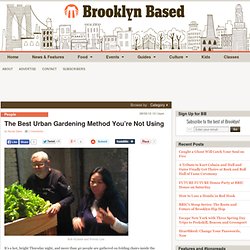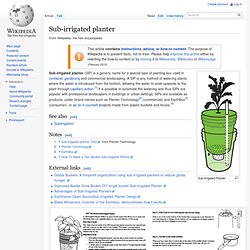

If You Build It, They Will Grow! Welcome to Above Ground Farming - Journal. The Best Urban Gardening Method You’re Not Using. Bob Hyland and Frieda Lim It’s a hot, bright Thursday night, and more than 40 people are gathered on folding chairs inside the Gowanus Studio Space.

A mix of ages, they are all here to listen to Bob Hyland, a 75-year-old expert in what he calls urban “greenscaping.” Some work in the industry, such as a a landscape architect and a carpenter who specializes in planters; some are home gardeners; a few traveled as far as Philadelphia. With sweat blossoming through his polo shirt and dripping down his brow, Hyland tells his rapt audience, “There has never been a better time or opportunity. I don’t know of a more wide-open field.” He’s talking about Sub-Irrigated Planters (SIPs), which Hyland explains is more of a system than a planter.
Frieda Lim is a convert. Hyland’s gardening experience has always been heavily rooted in cities. Custom-built SIPs SIPs systems come with their downfalls, as Hyland notes, which include a lesser use of compost and higher initial set-up costs. Sub-irrigated planter. Sub-irrigated planters (SIP) are simple devices that allow low-maintenance, low-water consumption container gardening.

A simple SIP has three major parts: a container for soil; a container for water; and a wick that allows water to be drawn from the water container into the soil container. The wick (typically made of fabric or polyester) draws water up into the soil through capillary action, where the plant roots absorb it at an appropriate rate for the plant. Aeration holes in the soil container, combined with overflow holes in the water container, help prevent the soil from becoming too wet (which may cause the plant roots to rot.) This diagram shows the major parts of a simple SIP made from a plastic pop bottle.
SIPs can be easily constructed from a variety of readily available (and commonly discarded containers) using simple tools. For instructions on making SIPs visit: 5-Gallon SIP Instructions It all starts with providing a water reservoir at the bottom of your container. Materials: 1. Inside Urban Green. Irrigated Planters Totes.pdf. Sub-irrigated planter. Sub-Irrigated Planter Sub-irrigated planter (SIP) is a generic name for a special type of planting box used in container gardening and commercial landscaping.

A SIP is any method of watering plants where the water is introduced from the bottom, allowing the water to soak upwards to the plant through capillary action.[1] It is possible to automate the watering and thus SIPs are popular with professional landscapers in buildings or urban settings. SIPs are available as products, under brand names such as Planter Technology[2] (commercial) and EarthBox[3] (consumer), or as do-it-yourself projects made from plastic buckets and boxes.[4] See also[edit] Subirrigation Notes[edit] External links[edit] How to make a DIY Two Bucket Sub-Irrigated Planter. Revolutionizing Urban Agriculture, One Sub-Irrigated Planter.